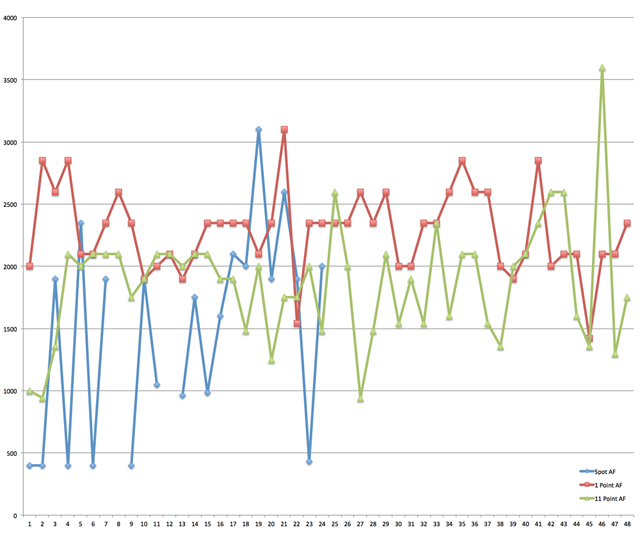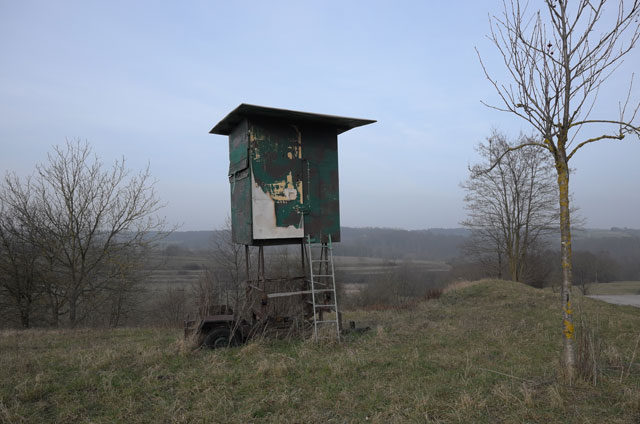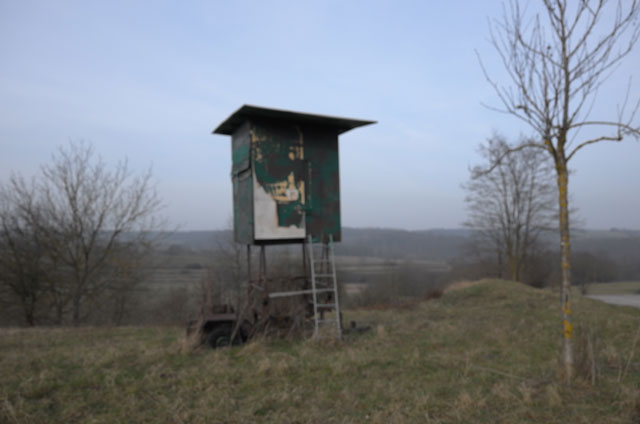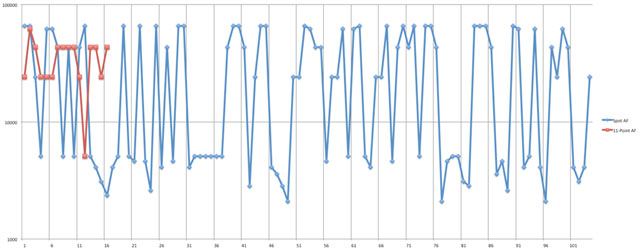Leica X Vario: Functional Issues - Autofocus (Tests)
Introduction | A First Investigation... | A Spot AF versus 1-Point AF Shootout | Preliminary Conclusions
Archive
While I like my Leica X Vario, it also has a number of functional issues or, in my opinion, deficits that need improvement. I list and discuss these on this and on related pages. Hopefully, most of the issues can be resolved in the future (a few were resolved with firmware update version 1.1)...
This page discusses photos that I took to produce autofocus (AF) errors hoping that this might help identify the conditions and causes for these errors. A further page examines AF issues in real world photos (my 2013 photos). An introduction to AF errors is also provided and should be read first.
Other functional issues are dealt with on page Functional Issues.
Note: The AF issues discussed here refer to the case that the camera signaled a correct focus (green rectangle(s)). The case that the camera cannot find focus and indicates this with a red rectangle is another matter. This may occur, for example, because there are no contours in the focus field.
Introduction
I conducted the informal investigations described below to provoke AF errors in order to prove that X Vario AF issues do exist. My hope was that the investigations, which are meant to supplement the experiences that I collected "in the field," help identify the conditions and causes for AF errors.
Please note that under "normal" shooting conditions, that is, in the real world, AF errors are much less likely to appear, if they appear at all - many X Vario users reported that they never had any issues with AF. Obviously, all depends on your shooting habits and your subjects.
A First Investigation...
In my first, a little more systematic, evaluation of the Leica X Vario's autofocus behavior (at the end of January 2014), I took 120 shots (24 with spot AF, 40 with 1-point AF, and 48 with 11-point AF) using a focal length of 18 mm. I did not count the number of shots, although it may look like this in hindsight... I also half-pressed the shutter release button many times in order to measure the distance with spot AF without actually taking photos. Thus usually suffices to find instances in which the focus is way off despite of a "green" focus confirmation (but you do not get any data).
My motif was located at a distance of about about 2 m. It was the front wall of a small hut with dark wooden framework, some objects hanging at the wall, and an oven and a plastic ton standing before the hut - large enough to irritate at least 11-point AF:

I did not select this motif deliberately - it is just on my terrace. Sometimes, a yellow oil lamp was visible above the electric lamp. It was also later in the afternoon, and therefore not very bright.
Some First Observations and Results for 18 mm
The vertical framework balk on the right side of the window had just the size of the spot AF field, while the 1-point AF field always included the white wall. This size difference is important to note, because only the spot AF signaled that it could not find focus (red rectangle). This happened because the balk, which was more or less uniformly dark, filled the spot AF field completely. However, in quite a number of occasions, spot AF signaled in "green" to have found focus under these conditions - and typically selected a very close distance (< 0.5 m) so that the focus was completely off.
Half-depressing the shutter release button measures both exposure and distance. I started my explorations with such tests (as far as I can remember, using spot AF only) and I often could clearly see that the focus was way off when the black log filled the spot AF field, while the camera nonetheless signaled with a green rectangle to have found focus. The focus was actually much more on target, when the camera signaled in red that it could not find focus.
I took 120 shots, 24 with spot AF, 40 with 1-point AF, and 48 with 11-point AF. I then inspected the Exif field 0x040a (first two bytes) for the distance. A value of up to 3000 just reflects the distance in mm (see here for details). Here are my observations for the three AF modes:
- Overall, there is a lot of variation in the data due to my non-standardized test procedure (no tripod, hand-held, not the same section for the photos, etc.) (see Figure below).
- 1-point AF seems to be the most reliable focus mode in this test, although there is one outlier beyond 3 m and there are two outliers at about 1.5 m.
- 11-point AF shows more variation and also lower distance values overall (indicated by the mean value of 1.87 m versus 2.28 for 1-point AF). Three shots lie in the 1 m region and might be regarded as "completely out of focus" (which is confirmed by the visual impression). More than a dozen shots lie in the 1.5 m range and may be regarded as "slightly out of focus." One photo has a distance beyond 3 m (also "slightly out of focus").
- The picture is different for spot AF for various reasons. Firstly, there were some shots where a red frame indicated that the focus could not be determined. Since I cannot identify the respective photos, I can only speculate that these are (1) the ones that lie in the 1 m distance region and (2) the ones that have an infinity distance setting. There are 6 out 24 photos with distance set below 0.5 m. These are definitely the ones, where the camera confirmed focus but missed it completely. Note that the results for this focus mode do not reflect real-world performance, since I tried to focus on the black log. One of the "infinity" photos looks completely fuzzy (perhaps it had green focus confirmation), while the other one looks only slightly fuzzy.
Figure: Exif distance values for three AF methods. The two missing values for spot AF (24 values only) correspond to 65535 = infinity.
Note: For an estimated correspondence between Exif distance data and real distances, see page Manufacturer-Specific Exif Data.
Brief Test with 46 mm
The next morning, I tested the camera on the same subject with a focal length of 46 mm. However, it was brighter than the day before. I mostly half-depressed the shutter release button, but also took 12 photos. I always pointed the spot AF to the framework at different locations on the right and upper side of the window. The balks showed clearly more "structure" that the AF could use than in the afternoon before.
The overall picture was different from the first test as well as similar:
- At 46 mm, autofocus often showed a red rectangle to indicate that it could not find focus, although it was never really "off" as in the cases where it signaled to have found focus and missed the target completely.
- It also confirmed focus showing a green rectangle (perhaps in about half the cases). Most often, it was correct (there was more structure discernible in the balk), in a few unpredictable cases, however, not at all.
All in all, I got the same mixture of focus confirmations as with 18 mm, but the other way round: There were many red signals, and few "green misses" - however, still enough to be worried about.
Repeating the Tests for More Focal Lengths and with Sunlight
Around noon, I repeated the tests with various focal lengths, also using uniform targets (e.g. the green plastic ton, a dark spot in the framework area). This time, it took much longer, or many more focusing attempts, to provoke "green" focus confirmations while the focus was "off." Nevertheless, such instances appeared all of a sudden - and sometimes one after the other. In the uniform areas, I also got a lot of red = negative focus confirmations.
All in all, spot AF focusing errors happened with all focal lengths and unpredictably.
Please note that this investigation used a setting in which I wanted to provoke focusing errors to prove their existence. Under normal shooting conditions, people may encounter them only rarely or even never.
Afternoon Retest with More Focal Lengths
I did a retest on the next day in the afternoon to find out whether my results would be replicable (115 shots). In had found that in better light, AF errors appeared more rarely, but nonetheless occurred and could be provoked (see my shootout below). In addition, I tested more focal lengths, because I had observed that AF fared better at higher focal lengths. I also varied the focus target much more than in the first test. All this means, that the retest was suited for a qualitative judgment but not for giving away any numbers.
All in all, I was able to produce focus errors (with "green" confirmation) for all four standard focal lengths (28, 35, 50, 70 mm equiv.) for both spot and 1-point AF, although subjectively the performance seemed worst at shorter focal lengths.
One More Afternoon Retest with 11-Point AF Included
On the third day, I did a smaller retest at a focal length of 18 mm that included spot AF, 1-point AF, and 11-point AF. Mostly, I just half-pressed the shutter release button to observe whether the focus was set correctly, but I also took a few photos to have some Exif data to inspect (37 shots in all). I retested spot AF and 1-point AF only to verify that focus errors could still be replicated, which was indeed the case. My main interest was to find out how 11-point AF would behave under these conditions.
All in all, there were fewer focus errors with 11-point AF, and these were not as dramatic as for the other two focus modes. Inspection of the Exif data revealed that distance was set to about 1 m in those cases (a little below and above). This is in line with my "real life" observations over the past, in which I often found that fuzzy images with 11-point AF had a distance setting of about 1 m. I will therefore discuss the 11-point AF issues under the label "slightly out of focus." I should also mention that the camera sent a "green" focus confirmation in all cases (it signaled a few "red rectangles" for spot AF). Thus, we still have a combination of "green" focus confirmations with wrong focus, albeit not as drastic as for the other two focus modes.
Retest with Tripod (Spot AF, 1-Point AF)
In the l-camera-forum, it was suggested that AF tests require the use of a tripod. I therefore repeated a few tests using a tripod on a gray day at noon (barjohn also did some tripod tests). My focus was, however, not on answering intricate questions, but simply to find out whether AF errors can be replicated when the camera is put on a tripod.
In this test, I used spot AF, either hand-held or on tripod, using the same dark framework spot as target that I had used for many of the shots described above. For all the shots, I got a "green" focus confirmation. I took hand-held shots to verify that AF issues appear under the testing conditions. This was indeed the case, and the distances that the camera set when used hand-held were a "mixed bag": 400, 2600, 400, 440, 65535, 65535, 677.
For the 15 tripod shots, however, the distance was set much more consistently: it was set to 440 once, and to 400 for all other shots (partly released by hand, partly using the self timer). The difference of 40 may relate to minimum step-motor steps.
I also took 6 shots with 1-spot focus (18 mm), pointing at the same target but with more surround. Here, I expected the AF to function correctly, which was indeed the case; the distance was set fairly consistently: 2350, 2350, 2100, 2100, 2100, 2100. Please note that in previous tests, when I encountered focus errors with 1-spot AF, I used a different focus target.
To sum up, AF errors appear also when the camera is put on a tripod, but due to the stable camera position, distance is set much more consistently. Thus, for simply demonstrating that AF errors appear the use of a tripod is NOT a necessity. It may well be a necessity, when one wants to answer certain questions.
A Spot AF versus 1-Point AF Shootout
I tested another motif with spot AF and 1-Point AF using a focal length of 18 mm in bright sunlight. I had used this motif in earlier test and already found some focus issues. The central object in the scene was at a distance of about 4 to 5 m. The motif looks like this sample photo (click photo for larger version):
A photo with a too close focus looks like this sample (click photo for larger version):
The photos were taken in quick succession; sometimes I waited a bit to allow the camera to store the photos on the SD card. In contrast to the first investigation, I did not treat spot AF differently from 1-point AF but used the same focus target. In the following, I summarize the results for both AF modes:
|
Spot AF
|
1-Point AF
|
|
| Number of shots | 43 |
52 |
| # of shots below 1 m | 8 |
0 |
| # of shots between 1m and < 2 m | 5 |
0 |
| # of shots between 2 m and < 3 m | 9 |
2 |
| # of shots at infinity | 4 |
2 |
As far as I can remember, there was always a "green" focus confirmation. With spot AF, there were 8 completely fuzzy photos, and none of those with 1-point AF. "Critical" are particularly shots with a distance of 2 m and below. For better sharpness, distance should have been at least 3 m.
But please note that the numbers in the table above are NOT representative, because in many cases, I did not take a photo, when the focus was OK. Again, I just wanted to document AF errors.
The figure below illustrates the variation of the Exif distance values:
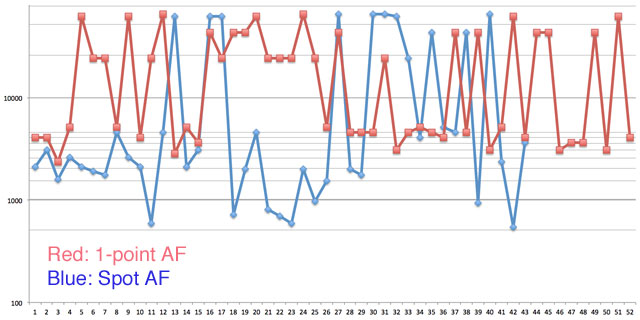
Figure: Logarithmic Exif distance values for two AF methods (1-point AF, spot AF)
Note: For an estimated correspondence between Exif distance data and real distances, see page Manufacturer-Specific Exif Data.
This time, I use a logarithmic scale to make differences at low distances values more apparent. Again, there is a lot of variation in the Exif distance setting. It would look even more pronounced if I had used a linear scale. On the other hand, the X Vario's Exif distance values are non-linear and rise sharply after about 4 m, suggesting much more variation than there really is.
Overall,1-point AF shows a much better performance in this test than spot AF, particularly regarding "too close" outliers. Spot AF also suffered from "wrong confirmations" in this test, whereas 1-point AF did not.
Re-Shootout
On the following day, I did a re-shootout, which included spot focus AF and 11-point AF (all tests were done at a focal length of 18 mm). Perhaps, because of the somewhat better lighting conditions, I could not reproduce any "gross" AF issues (half-pressed shutter and 120 photos). A closer inspection of the photos, however, revealed a number of "slightly" misfocused photos for spot AF. In most cases, the focus was set to a distance of a little more than 2 m (while the main object was about 5 m away). One of the fuzzy photos showed a distance of infinity in the Exif data, whereas all the other photos where distance was set to infinity were OK. Thus, at least spot AF also seems to suffer from "slight AF" issues - whereas the camera always gives a "green" focus confirmation.
The following figure shows the distance variations of this session:
Figure: Logarithmic Exif distance values for two AF methods (spot AF = blue, 11-point AF = red)
Note: For an estimated correspondence between Exif distance data and real distances, see page Manufacturer-Specific Exif Data.
While the image section varies from time to time, the difference in the distance values is perplexing (although it is exaggerated by the scaling used in the Exif distance data)...
Preliminary Conclusions
Preliminary Conclusions for Spot and 1-Point AF
Taking together barjohn's and my results, enough evidence has been collected to conclude that on certain occasions - and for unknown reasons - spot and 1-point AF signal to have found focus but miss the target completely (typically the camera sets a distance of about half a meter in such cases).
The picture may be somewhat different for different focal lengths and perhaps lighting conditions, but the fact of wrong focus confirmation coupled with a completely "off" distance setting exists at all focal lengths. In my opinion, both issues - incorrect focus confirmation and missed focus - go together. But note that Ricoh states in the GR manual that wrong focus confirmations can happen under certain conditions.
Tripod tests show that AF errors also occur when a tripod is used. But the distance settings are much more consistent than when the camera is used hand-held.
I did not look more closely at "near misses" when using spot and 1-point AF, particularly because I mostly used 11-point AF at the beginning. But a re-test suggests that such "milder" focus errors may occur in these focus modes as well - and in the same unpredictable manner. At least, spot AF may tend to make "slight" AF errors, setting the distance to about 2 m, although the object is farther away. This may be the case under better lighting conditions, but at the moment this is just a speculation.
Preliminary Conclusions for 11-Point AF
When 11-point AF fails (but indicates to have found correct focus), the camera typically sets a distance of about a meter. Thus, the photos do not look as blurry as in the case of focus errors for spot AF and 1-point AF. Here, the problem is that such errors are much harder to detect in the viewfinder (on the fly). You only find them when you inspect your photos at home, but then it's too late.
11-point focus errors seem to occur more rarely than the drastic focus errors for spot and 1-point AF. Nevertheless, they occur - unpredictably - and may ruin valuable photos (which led me to take each photo at least twice...).
The Infinity Issue
There are rare cases, in which the photo is completely blurred* as if the camera had selected a nearby focus point (according to visual inspection), but the Exif data lists a distance of infinity (65535). Here, we have the issue that the Exif data does not correspond the the camera's actual distance setting (infinity would be the correct distance). This may either be a related or separate issue. I re-discovered it just recently, that is, in March 2015. So, it is still there...
*) Note that there many be similar photos in a set of photos, where the camera lists the same distance (infinity) - and these photos are sharp (as they should be).
| 03.04.2019 |
